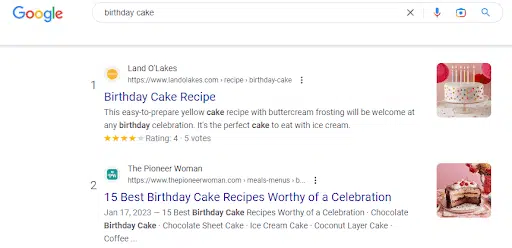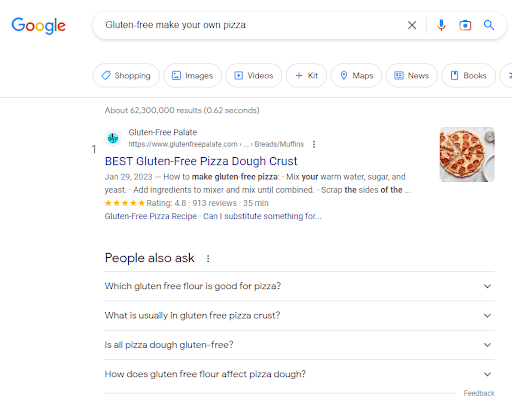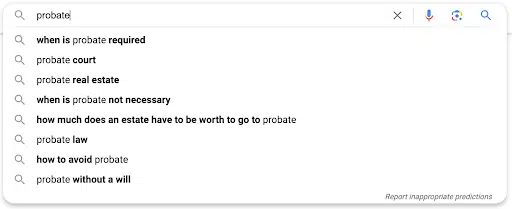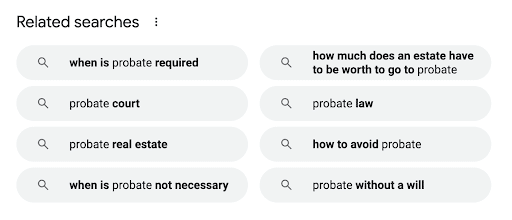-
by Zach Hoffman
In today’s digital world, both social engagement and interaction are key to successful advertising and marketing. The goal is to stand out from your competition, understand your target audience, and make a meaningful connection with them in the long term. After all, people do business with people they know, like, and trust.
That, however, means that you need to remain relevant in your advertising, especially regarding internet advertising and website landing pages. And that begins with a tried and true SEO (Search Engine Optimization) strategy. The success or failure of your SEO strategy requires some keyword research – determining which keywords will be used in your campaign. This begs the question(s):
What is the difference between long tail vs short tail keywords in SEO?
Which should you focus on first: short tail vs long tail keywords?
And how do you even find the right keywords to rank for?
Discover that inside this guide.
Contact your SEO experts at Exults to start generating organic traffic to your website.
What’s The Difference Between Long Tail vs Short Tail Keywords In SEO?
If you’re new to the world of SEO and how search engines (i.e. Google, Bing, and Yahoo) work, you may have heard the terms “long tail” and “short tail” keywords thrown around. Essentially, short tail keywords are shorter phrases that are more general in nature, while long tail keywords are longer phrases that are more specific and targeted.
Both are important to include in your overall SEO strategy. But what’s the difference between long tail vs short tail keywords in SEO? And which should you focus on first?
What Are Short Tail Keywords In SEO?
Before deciding on which to use for your advertising campaign, it is important to understand the difference. Short tail keywords are a maximum of three words
Here are a few examples of short tail keywords:
- Birthday cake
- Pineapple necklace
- 1939 food prices

Also known as “head terms” in SEO, these are the first words that come to mind when deciding where to eat “sushi” or “gluten-free pizza”, finding a birthday gift for grandma (“bracelet charms” or “petite women’s apparel”), or where to take your furry friends on a walk (“dog parks” or “dog-friendly hikes”). Short tail keywords are broad in scope and return large amounts of traffic – often way more than you need to target to reach your SEO goals.
What Are Long Tail Keywords In SEO?
In comparison, long tail keywords are more than three words, considerably more targeted and specific. Although they typically won’t return as much organic traffic, they will attract more of the traffic you need to target. Examples include:
- 80th birthday bracelet charms
- Gluten-free make your own pizza
- Easy dog-friendly hikes near me

For marketing and advertising, long tail keywords are often the most favorable – but both have positive and negative attributes.
The Pros and Cons Of Long Tail Vs Short Tail Keywords
When you want to make a big impression on the first search engine results page (SERP), both long tail and short tail keywords can work to your advantage. Many long tail keywords used together in a campaign can mean substantial volume while generic short tail head terms will drive loads of search traffic to your site.
Pros Of Long Tail Keywords
Long tail keywords have a higher click-through rate (CTR) generally because of less competition or fewer search returns. In turn, this means lower cost per click (CPC) as low-bidders mean lower prices, plus long tail keyword search queries result in higher positions. Long tail keywords often result in a higher conversion rate simply because you are attracting more of your targeted audience with more specific head terms. You engage them in their searching often when they are already in a decision-making mode and ready to make a purchase.
Cons Of Long Tail Keywords
But what about the bottom line or return on investment (ROI)?
Regarding website content, you will need to create more original content intended to connect with your target audience – no matter how narrow. While the long tail keywords will come naturally as part of the conversation, it may require you to produce more content than you originally intended.
Pros Of Short Tail Keywords
Short tail keywords are easy to develop for your content strategy, but you need to ensure these short tail keywords flow easily, not awkwardly, into the subject matter. Having keywords that fit naturally, will increase your quality score as well as your relevance among your audience members.
Cons Of Short Tail Keywords
Because short tail keywords are broader in general, you will also see a higher CPC per term. Additionally, your ads may show up for users who are not your target audience or even in a position to engage with your brand on some level.
How To Find The Right Keywords For SEO Success
Doing your research and knowing your target audience will aid you in the selection of the best long tail and short tail keywords for your business. Should you need assistance, please contact us to optimize your next campaign for success.
Make A List Of Topics
In order for you to find the right keywords for your business, you need to think of the overarching topics you are known for. Not only are topics like these typically easy for clients to discuss and offer valuable information for, but they also often use the same keywords or phrases as your target audience – so it’s a win-win.
For an estate planning law firm, their topics may be wills, estate plans, and probate. Then a family law and child custody law firm’s topics could include custody, divorce, adoption, and child support. From the general services your business offers, you should be able to have those general topics to start thinking about the rest of your digital marketing plans. Again, these are broad topics that will help you with the next step in finding the right keyword for your SEO success.
Strategize With Marketing Professionals
If you don’t have any marketing experience or professionals directly on your team, using a digital marketing agency can give you the insight you need to make informed decisions about your campaigns.
If you’re going the strategic route without a digital marketing expert in your corner, you can do some light keyword strategy on your own. There are paid and free digital tools available to you like Google’s Keyword Planner (check out this quick how to) and Semrush.
However, it’s important to keep in mind that without knowing in-depth where your business stands regarding keywords, the data you see may not be that helpful for long-term results. You might find yourself running into extremely general keywords and phrases or ones that are not relevant to your business at all. An SEO expert will have the knowledge needed to guide your optimization strategy, integrate it with your additional assets, and identify the long tail vs short tail keywords that may perform best for your business.
Don’t sleep on using digital marketing professionals for your business. Give Exults a call and experience the difference.
Record & Maintain Your Findings
Whether you’re a firm believer in spreadsheets and Word documents or laptop notes and a mood board, ensure you’re recording your findings as you research various digital marketing topics and ideas like finding the difference between long and short tail keywords and how it applies to your business.
See a topic you could talk about for days on end that would be better to bring up at a certain time? Save that topic to fill out content ideas for future months. Every time you think of a topic you want to cover, jot it down so it doesn’t get lost.
On the other hand, simply jotting down your ideas may not be enough to give you the strategy you need for your desired SEO results. This is why Exults’ team of digital marketing experts works well for business owners across all industries. Because you’re able to leave your digital marketing in the hands of someone else, you also save yourself the time it would take to conduct regular keyword research sessions.
Think of digital marketing management for content and blogs as the gift that keeps on giving. Remember, having a routinely updated topic list allows you to plan and reuse other assets like videos and downloadable guides. Nailing this part of your strategy also keeps your entire team organized and on the same page about month-to-month goals. It’s time-consuming work, but it’s the best way to track those keywords and bring your brand in front of a wider audience.
Fill Those Topic Categories With Keywords
Now that you have your topics, write keywords down that fit into those categories. Use the following questions to help you brainstorm:
- What is my target audience searching for?
- What questions does my target audience ask frequently?
- Is there anything I wish my target audience knew about this topic?
- Are there any interchangeable terms I should alert my audience about?
- Would it help my audience to have a glossary available with common industry words and phrases broken down?
- What are the myths people believe most about my business?
When you spend adequate time strategizing, recording, and maintaining these keywords in your various topics, you are in a much better position to keep your entire team – both internal and external – on a streamlined track to success. Plus, you’ll be able to better track your best-performing keywords.
Use Your Google Search Console To Find Keywords
Then log onto your Google Search Console for additional keyword inspiration. Search under queries.
Write down the keywords that you already rank for. Find different ways to communicate those terms.
You can also find keywords that have a lot of impressions but aren’t ranked. That indicates a good traffic opportunity for your business.
Determine Intent Behind Keywords
Some keywords you may have listed or come up on search engines for may be all good, but the intent behind those keywords may not drive the right traffic to your website.
What’s the easiest way to determine the intent behind keywords? Search the term. The results in the paid ads and organic results sections of the SERP should be along the same lines as your intent. If it’s not, then you may need to look at a different keyphrase. Remember, just because it’s what you would search for doesn’t mean that’s what your target audience is plugging into the search engines.
You can also use this strategy to promote job openings and related opportunities. If you’re not familiar with how keywords work for your career-based tasks, think about what potential employees would search for if they wanted a job like the roles you’re offering. Depending on your industry and the roles available, a few common keywords might include:
- Companies hiring near me
- Job openings near me
- Upcoming job fairs
- Accounting jobs around me
- LinkedIn job search
If you’re in a specific industry, that’s okay. Keywords can range from broad searches to search terms that are quite detailed like:
- Entry level dental assistant job openings near me
- Senior CPA job opening in oil and gas industry
- Operations management roles in health and medical field
- Entry level accounting role in financial equity firm
- Paralegal job at family law firm for divorce attorneys
Use Google’s Autocompletion, Related Search, & People Also Ask For Inspiration
If all else fails, use Google’s Autocompletion, Related Search, and People Also Ask for inspiration for your keywords. While originally these features were produced to make their user experience better for searchers, they can be used to boost your keyword planning. These tools will be able to help you build long tail vs short tail keywords to start optimizing.
Autocompletion
When you search for a term in Google, they will automatically spit out other prospective keywords for you to try out. Google originally intended this to help users find the information they are searching for quickly. But as a business, you can use it as preliminary keyword research.

Related Search
Similarly to Autocompletion, the Related Search feature helps users find the information they are searching for quickly rather than forcing them to click through pages of search results.

People Also Ask
Lastly, the “People Also Ask” feature helps prompt potential results for users to click through. Oftentimes, the best SEO pages start with a question as Google can scrap that information and quickly provide an answer to their users.

Now that you have a list of keywords, you need to create content around those terms. Don’t go about it alone! Start the conversation with Exults today.
SEO Keyword Frequently Asked Questions
There is a lot of noise surrounding SEO keywords. That’s why we’ve compiled the SEO keyword frequently asked questions to help guide you in your SEO efforts.
What Is An SEO Expert?
An SEO expert or specialist is someone who understands how search engines work and more importantly, how to rank websites on those popular search engines. They may focus on 1 of 3 areas, but they should have a basic understanding of all 3.
What are the 3 areas?
- On-Page SEO
- Off-Page SEO
- Technical SEO
On-page SEO usually refers to the optimization of the words and keywords written on each page throughout a website. In addition, it includes adjusting the title tags, crosslinking, meta descriptions, and URLs. They’ve developed a process that allows Google (and other search engines) to see their content as valuable and on topic.
Off-page SEO refers to any optimization that occurs outside the website itself. That includes backlinks most commonly, public relations (PR), and social media.
Finally, technical SEO refers to the backend of the website, including tasks like:
- Creating and submitting the sitemap to search engines
- Optimizing the site structure to make it easy to navigate
- Increasing site speed
- Designing the site to be mobile-friendly
- Removing any duplicate content found on the site
How Would Hiring An SEO Agency Benefit My Business?
There are several reasons why you should hire an SEO agency and how it would benefit your business.
First, they can help you save time so you can offload SEO tasks to a full team of experts and focus on what you do best. You’ll also skip the learning curve required to optimize your site for search engines. This alone will help you better manage your time.
Then, it will save you both time and resources as an agency can be more cost-effective than hiring an in-house SEO specialist. Plus, you now have access to a full team for the same price. As a result of them analyzing data from multiple industries and businesses, they can provide advanced suggestions to bring you further than your competitors.
And because you have your time back and costs optimized, you can improve your productivity and results in other areas of your business. Working with an SEO agency is the start of taking on more market share.
Want to partner with an SEO agency that has your business’s best interests in mind? Partner with Exults.
Which Type Of Keywords Should I Use For My Business?
The type of SEO head terms you should use for your business depends on a variety of factors, including your target audience, industry, and business goals. Generally speaking, it is a good idea to focus on long tail keywords that are specific to your products or services that have a lower search volume and low competition.
If you are struggling to find long tail keywords that work for your business, start with identifying overarching topics and short tail keywords. Then use that as a point to differentiate into a variety of terms.
For example, a Home Services company may offer HVAC, roofing, and plumbing services under the same brand. Because those services are so different from one another, start with one and identify 3-5 topics per service.
- Roofing
- Roofing Materials
- Metal roofs vs architectural shingles
- What is the best roofing material in Florida?
- Hurricane-proof roofing materials
- Roofing Maintenance
- Roofing Replacement
- Roofing Materials
At the end of the day, the head terms you should use are the ones your target audience is searching for.
Which Is Better Long Tail Or Short Tail Keywords?
If you’re looking to cast a wide net and attract a large audience, short tail keywords may be the way to go. Because of the high competition, you’ll need to put in a lot of work to see any of those short tail head terms rank.
If you’re looking to target a specific niche or audience with highly relevant content, long tail keywords may be a better fit. Using long tail head terms makes it easier for a given page to rank on search engines in comparison to its short tail counterparts.
Ultimately, it’s important to research your audience and competition and choose the keywords that will best help you reach your goals.
How Do You Come Up With Long Tail Keywords For Your Website?
To come up with long tail keywords for your website, start by brainstorming words and phrases that are related to your business or industry. Consider using keyword research tools such as Google AdWords Keyword Planner, SEMrush, or Ahrefs to identify relevant keyword suggestions and their search volume. Think about user intent when searchers look up your focus key phrases.
Why It Is Important For A Company To Use Long Tail Keywords In An SEO Optimization Strategy?
Relying solely on short tail keywords for your SEO strategy lends itself to lower conversion rates and increased traffic – creating a sense of frustration for business owners.
When a company uses long tail keywords in its SEO optimization strategy, it may see lower traffic. However, that traffic is going to be higher quality leads that in turn produce a higher conversion rate. All of your marketing efforts will be much more fruitful as a result.
What’s The Difference Between Keyword And Keyphrase?
Although we used the word “keyword” throughout this blog, the term keyword indicates a one-word term someone would search for. For example, it could be “lawyer”. The word “keyphrase”, on the other hand, indicates more than one word. This could look like “divorce lawyer in miami florida”.
Leave Your Short Tail vs Long Tail Keywords & Other SEO Worries At Exults’ Door
The layers involved with a successful digital marketing campaign are extensive and require specialized attention. Partnering with Exults gives you the freedom to focus on what you do best while your digital marketing continues to grow, adjust, and thrive.
Have an idea of what your upcoming goals are to further support your online presence? From long tail vs short tail keywords and paid advertising to social media and website updates, Exults does it all.
Give us a call at 877-355-9269 today to get started.

